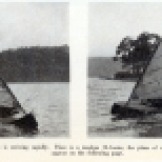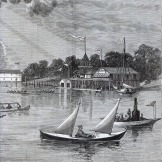At the end of the last post, you’ll remember that had just fitted and fastened one garboard? Well, when we went to trim the rough end of the planking the next day, a split developed near the stem where the plank twists the most. There was already a little split at the scarph, and we started to think that perhaps that plank should come off. As we were looking at it to make the decision, the plank decided for itself, splitting even further. So, off it came, which meant pulling the fastenings, pulling the plank, cleaning off the sealant and plugging the fastening holes with dowels. The twist in the garboard planks from midships to the end meant that there was too much tension in the plank (rule number one: there should always be more tension on the boatbuilder than on the plank!). So, for the next round, we soaked the stem end in boiling water.
The plank was then clamped to the form and allowed to dry. When it was removed, it sprang back a little ways ( probably more than it would have if we had steamed it properly) but retained enough shape that there wasn’t a lot of tension exerted in the final fitting and and the fastenings were holding it in place instead of pulling it into place.
So, once more we fastened the garboard on. This time, we followed the suggestion of the designer and added a couple of drywall screws with washers under their heads from the garboard into the bottom just to hold the plank in close while it was fastened, because it’s not possible to get a clamp in that joint.
With the plank held in place, the fastening holes are marked and drilled with a 1/16” pilot hole.
One at a time, the copper tacks are driven from the outside and clenched inside on the bottom.
The tools of clench-nailing, left to right. A backing dolly. This can be any heavy piece of metal, but I like these panel-beater’s dollies used by auto body shops. They’re nicely curved to fit inside the hull, have a good handle and cost a lot less than the fancy canoe-builder’s clenching irons. Then, a box of 5/8” sharp-pointed cut copper tacks and finally a hammer. A nice small hammer, not a big beastly 16 oz. framing hammer. Clenching requires a series of light, fast strokes to gradually turn and set the nail on the inside of the boat. Oh, and coffee. Can’t build boats without coffee.
While tapping from the outside, the inside hand holds the dolly tight to the point of the nail, gradually turning it into the wood down (towards the bottom of the boat) and across the grain for best holding power.
The 10:1 scarph has been cut in the plank on the bench before it gets fastened in the boat.
The other half of the garboard is overlapped, and the start and finish of the scarph joint are transferred to it. You can also see where the fastenings have been marked out.
The finished scarph. The fastenings are driven from the outside in at the thin end, and the inside out at the thick end. We really should have turned the points of the clench nails more down and across the grain for best holding power. The bottom of the scarph will be faired up before the next plank is fitted.
The other end of the garboard fastened in place, showing the #6 x ¾” screws in the garboard and the #8 x ¾” in the stem.
After fastening, the ends are roughly trimmed to make room for the plank on the other side.
After sawing close to the line, the rough trimming is finished with a spokeshave.
Fitting the second garboard. Where it’s difficult to put a clamp, you can use a “hutchet,” a piece of scrap stock that holds the plank in place.
The second garboard fitted and waiting to be trimmed.
Using the lower edge of the plank as a guide, the laps are marked out. Here, they are 5/8″ wide.
Before beveling the laps, I took a few minutes to trim the edges of the fitted and fastened garboards flush with the bottom.
In order to make the plank edges lie against each other on the lap, the upper edge of the lower plank (once the boat is right side up, that is) needs to be beveled. There are five places on each side of the boat where you can find out what the bevel should be: at each end, where it tapers to a feather edge; at the two watertight bulkheads and at the midships frame.
Placing a straight edge on the mark showing the edge of the next plank will tell you how much needs to be taken off. What you’re aiming for is to have the straight edge touch the pencil line showing the upper limit of the lap, so as you can see, there’s quite a corner there now to be removed.
Until next time. . .



























































Leave a comment